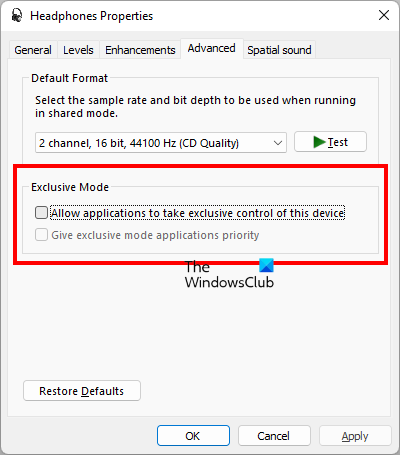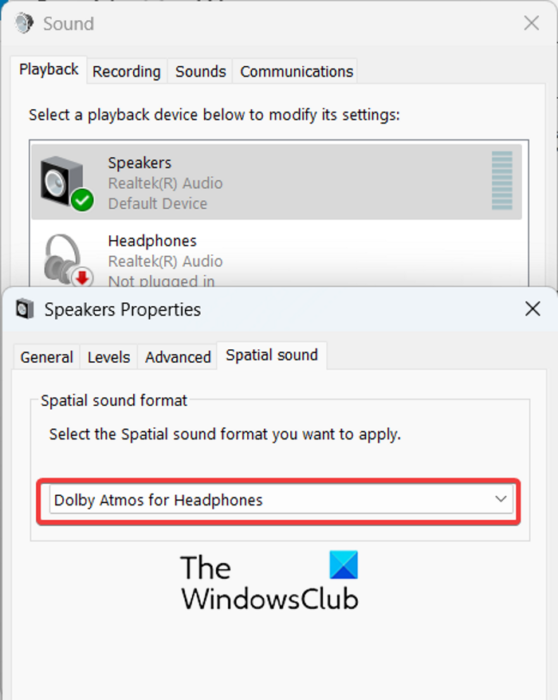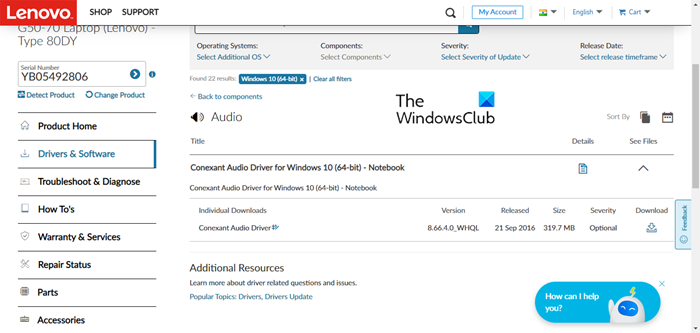Does the Spatial sound setting keep switching or reverting to Windows Sonic itself on your computer? Some Windows users have complained that their Spatial Sound settings keep changing and reverting to Windows Sonic itself. This condition generally occurs whenever the computer is rebooted or hibernated. As a result, the users who have paid for Dolby Atmos or DTS sound are unable to enjoy a great audio experience while gaming or watching movies.

Spatial sound refers to sound playback technologies that offer an enhanced atmosphere in a 3D virtual space with surround sounds. It is primarily used while watching movies or playing games to enhance the overall experience. You can enable or disable the spatial sound according to your requirement.
This issue could be a result of several factors. It might be due to outdated sound drivers. Or, you might face the issue if you have enabled Exclusive Mode for your playback device. Besides that, the corrupted spatial sound app can be another reason for the same.
How do I turn off Windows Sonic and Spatial sound?
To disable the spatial sound on Windows 11, open the Settings app using Win+I and go to the System > Sound option. Next, under the Output section, select your output sound device to open related settings. After that, scroll down to the end of the page and click on the Spatial audio drop-down option. Next, choose the Off option to turn off the spatial sound.
Spatial Sound keeps switching to Windows Sonic
If the Spatial sound keeps reverting or swirching to Windows Sonic on your PC, you can use the below solutions to fix the issue:
- Run the Playing Audio troubleshooter.
- Disable exclusive control of your playback device.
- Enable Spatial Sound using a dedicated app like Dolby Access or DTS Sound Unbound.
- Update your sound drivers.
- Repair or uninstall and reinstall the Spatial sound app.
1] Run the Playing Audio troubleshooter
Before getting into advanced troubleshooting steps, we recommend you run the inbuilt audio troubleshooter. If there is some generic issue that is why you are facing this problem, the Windows Audio troubleshooter should be able to detect and fix audio-related problems and bugs. Here are the steps to run it:
- Firstly, hit the Win+I hotkey to open the Settings app quickly.
- Now, go to the System tab and click on the Troubleshoot option from the right side.
- After that, press the Other troubleshooters option to view Windows inbuilt troubleshooter.
- Next, scroll down to the Playing Audio troubleshooter and click on the Run button Windows will start detecting audio-related issues on your system and list them on the screen. In addition, it will also recommend suitable fixes that you can use to fix the issues; apply an appropriate fix.
Once done, check if the problem is gone.
See: Razer 7.1 Surround Sound not working in Windows.
2] Disable exclusive control of your playback device

As reported by some affected users, disabling exclusive control for their devices helped them fix the issue. So, you can also try doing the same and see if the issue is resolved.
The Exclusive Mode feature lets certain audio applications take exclusive control of your audio device drivers. Now, if enabled, sound optimization, equalizer, or some other app on your computer might be overriding the spatial sound property and causing this issue. Hence, disable the Exclusive Mode for your playback device to fix the issue. Here’s how:
- First, open the Settings app by pressing Win+I and move to the System tab.
- Now, tap on the Sound option and click on the More sound settings option.
- After that, move to the Playback tab and right-click on your active audio playback device.
- Then, select the Properties option from the appeared context menu.
- Next, navigate to the Advanced tab and untick the checkbox associated with the Allow applications to take exclusive control of this device option.
- Finally, click on the Apply > OK button to apply new settings.
See if the problem is fixed now.
Read: Something went wrong while trying to turn on Spatial Sound.
3] Enable Spatial Sound using a dedicated app like Dolby Access or DTS Sound Unbound

If you are unable to change the spatial sound setting from Windows Sonic via Sound Settings, you can use the dedicated app to customize your preferences. In case you use Dolby Atmos, you can download and install the Dolby Access app to change the spatial sound settings. DTS users can get the DTS Sound Unbound app to change their sound configurations.
For example, if you want to use Dolby Access, open Microsoft Store and search for the Dolby Access app. After that, click on the Install button on the app. Once the app is installed, open it and configure settings accordingly.
After that, open Settings, click on the Sound > More sound settings option, right-click on your device in the Playback tab, and choose the Properties option. Now, move to the Spatial sound tab and select the Dolby Atmos for Headphones option as Spatial sound format. When done, press the Apply > OK button and reboot your computer. Hopefully, you won’t experience the same issue now.
Read: Fix Channel Surround Sound not working in Windows.
4] Update your sound drivers

If the above solutions don’t work, ensure your audio drivers are up-to-date. Out-of-date and corrupted audio drivers cause audio-related issues on your computer. Hence, update your audio driver and check if the issue is resolved.
To do that, open the Windows Settings using Win+I, navigate to the Windows Update tab, and press the Advanced options > Optional updates option. You can now install audio driver updates by ticking the respective checkboxes and clicking the Download & install button. Lastly, reboot your PC to complete the process and see if the problem is resolved.
You can also directly download and install Audio drivers.
5] Repair or uninstall and reinstall the Spatial Sound app
If you are using a spatial sound application like Dolby Access for customizing your spatial sound preferences, try repairing the app. It might be the corruption associated with the app that is causing the issue. Hence, you can fix it by repairing the app using Settings. Open Settings, go to Apps > Installed apps, click on the three-dot menu button with the app, and select Advanced options. After that, click on the Repair button and check if the problem is resolved.
If repairing the app doesn’t work, uninstall the app by launching Settings. Go to Apps > Installed apps, scroll down to the spatial sound app, and select the three-dot menu button. After that, choose the Uninstall option and follow the prompted steps to complete the process.
Once done, reinstall the app from Microsoft Store and reconfigure it to check if the problem is fixed.
How do I stop Windows from switching to Windows Sonic?
If the spatial sound setting keeps reverting to Windows Sonic on your PC, you can use the dedicated spatial sound app like Dolby Access to change your preferences. Besides that, you can launch the inbuilt audio troubleshooter and check if it is able to address this issue. Additionally, ensure that your sound driver is up-to-date, disable exclusive control, or repair or reinstall the spatial sound app you are using.
Now read: THX Spatial Audio not working on Windows.
Leave a Reply